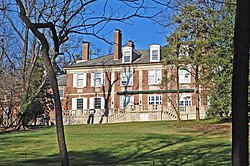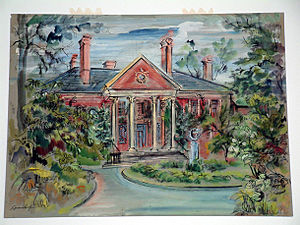
Biltmore Estate is a historic house museum and tourist attraction in Asheville, North Carolina. Biltmore House, the main residence, is a Châteauesque-style mansion built for George Washington Vanderbilt II between 1889 and 1895 and is the largest privately owned house in the United States, at 178,926 sq ft (16,622.8 m2) of floor space and 135,280 sq ft (12,568 m2) of living area. Still owned by George Vanderbilt's descendants, it remains one of the most prominent examples of Gilded Age mansions.

Cleveland Park is a residential neighborhood in the Northwest quadrant of Washington, D.C. It is located at 38°56′11″N77°3′58″W and bounded approximately by Rock Creek Park to the east, Wisconsin and Idaho Avenues to the west, Klingle and Woodley Roads to the south, and Rodman and Tilden Streets to the north. Its main commercial corridor lies along Connecticut Avenue NW, where the eponymous Cleveland Park station of the Washington Metro's Red Line can be found; another commercial corridor lies along Wisconsin Avenue. The neighborhood is known for its many late 19th century homes and the historic Art Deco Uptown Theater. It is also home to the William L. Slayton House and the Park and Shop, built in 1930 and one of the earliest strip malls.

Gore Place is a historic country house, now a museum, located at 52 Gore Street, Waltham, Massachusetts. It is owned and operated by the nonprofit Gore Place Society. The 45-acre (180,000 m2) estate is open to the public daily without charge; an admission fee is charged for house tours. A number of special events are held throughout the year including an annual sheepshearing festival and a summer concert series.

Charles Adams Platt was an American architect, garden designer, and artist of the "American Renaissance" movement. His garden designs complemented his domestic architecture.

Ellen Biddle Shipman was an American landscape architect known for her formal gardens and lush planting style. Along with Beatrix Farrand and Marian Cruger Coffin, she dictated the style of the time and strongly influenced landscape design as a member of the first generation to break into the largely male occupation.

Stan Hywet Hall & Gardens is a historic house museum in Akron, Ohio. The estate includes gardens, a greenhouse, carriage house, and the main mansion, one of the largest houses in the United States. A National Historic Landmark, it is nationally significant as the home of F. A. Seiberling, co-founder of the Goodyear Tire and Rubber Company.

Warren Henry Manning was an American landscape designer and promoter of the informal and naturalistic "wild garden" approach to garden design. In his designs, Manning emphasized pre-existing flora through a process of selective pruning to create a "spatial structure and character." An advocate for the conservation of the American landscape, Manning was a key figure in the formation of the American Society of Landscape Architects and a proponent of the National Park System.

The Graycliff estate was designed by Frank Lloyd Wright in 1926, and built between 1926 and 1931. It is approximately 17 miles southwest of downtown Buffalo, New York, at 6472 Old Lake Shore Road in the hamlet of Highland-on-the-Lake, with a mailing address of Derby. Situated on a bluff overlooking Lake Erie with sweeping views of downtown Buffalo and the Ontario shore, it is one of the most ambitious and extensive summer estates Wright designed. It is now fully restored and operates as a historic house museum, open for guided tours year round. There is also a summer Market at Graycliff, free and open to the public on select Thursday evenings. Graycliff Conservancy is run by Executive Director Anna Kaplan, who was hired in 2019.
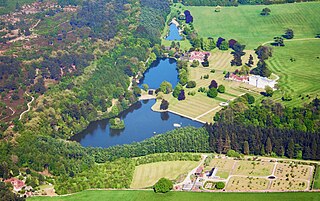
Witley Park, formerly known as Lea Park, is an estate dating from the late 19th century between Godalming and Haslemere in Surrey, England. Its landscaped grounds include three artificial lakes, one of which conceals an underwater conservatory and smoking room. The mansion house, rebuilt for the swindler Whitaker Wright, was gutted by fire in October 1952 and the ruins were demolished in January 1954. In the early 21st century, a new house was built on the site.
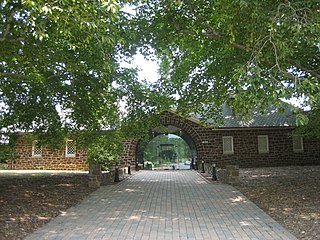
The Belair Stable Museum is located at 2835 Belair Drive in Bowie, Maryland. It is operated by the City of Bowie, Maryland. The building once housed the Belair Stud Farm until 1957 when the Woodward family sold the Belair Estate to Levitt & Sons for the construction of Belair at Bowie.

Montgomery Place, now Bard College: The Montgomery Place Campus, near Barrytown, New York, United States, is an early 19th-century estate that has been designated a National Historic Landmark. It is also a contributing property to the Hudson River Historic District, itself a National Historic Landmark. It is a Federal-style house, with expansion designed by architect Alexander Jackson Davis. It reflects the tastes of a younger, post-Revolutionary generation of wealthy landowners in the Livingston family who were beginning to be influenced by French trends in home design, moving beyond the strictly English models exemplified by Clermont Manor a short distance up the Hudson River. It is the only Hudson Valley estate house from this era that survives intact, and Davis's only surviving neoclassical country house.

Andalusia, also known as the Nicholas Biddle Estate, is a historic mansion and estate located on the Delaware River, just northeast of Philadelphia, in Bensalem Township, Bucks County, Pennsylvania. The community surrounding it, Andalusia, takes its name from the 225-acre estate.
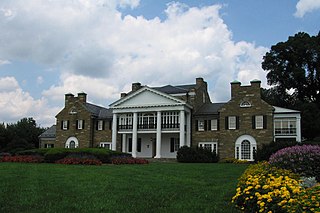
Glenview Mansion is a historic home and surrounding property located at Rockville, Montgomery County, Maryland. The house is a 1926 Neo-Classical Revival style house on 65 acres (260,000 m2) of landscaped ground. The five-part mansion incorporates the remnants of the 1838 house called "Glenview." Since 1957, the house and grounds have been owned by the City of Rockville, and are used for various civic, cultural and social events, and is known as Rockville Civic Center Park. The house also includes the Glenview Mansion Art Gallery.

The Elkins Estate is an American 42-acre (170,000 m2) estate located in Elkins Park, Montgomery County, Pennsylvania. The estate contains seven buildings, the most notable being Elstowe Manor and Chelten House, mansions designed by Horace Trumbauer.

James Parmelee (1855-1931) was a Cleveland financier.

Meadowlands, at 274 Middlesex Road in Darien, Connecticut, USA, also known as DCA Meadowlands or the Darien Community Association House, enjoys a long, distinguished history. The original house was owned by Mary and Frank Green, a wholesale grocer from New York City. Green built his expansive home in the Victorian style in 1876 and resided there until 1915. The home was then bought in 1918 by Charles D. Lockwood, one of the founders of the law firm Cummings and Lockwood. Covering 52 plus acres, the property extended from Middlesex Road and Leroy Avenue to West Avenue. The property operated as a farm with cattle, chickens and fruit trees. The house at that time had on the first floor a parlor, library, hall, dining room, butler's pantry, china closet, and kitchen; second floor included four bedrooms, all with adjoining baths; and the third floor held one large bedroom and three servants' rooms.

Untermyer Park and Gardens is a historic 43-acre (17 ha) city public park, located in Yonkers, New York in Westchester County, just north of New York City. The park is a remnant of Samuel Untermyer's 150-acre (61 ha) estate "Greystone". Situated on the steep land arising from the eastern bank of the Hudson River to the bluff on top of it, the park's principal feature is the Walled Garden, inspired by ancient Indo-Persian gardens, in which are found a small Grecian-style open-air amphitheater with two opposing sphinxes crouching atop paired Ionic columns; a classical pavilion; a stoa and loggias; and a circular, open-air tempietto called the Temple of the Sky. A long staircase leads from the Walled Garden to an Overlook with views of the river and the Palisades.
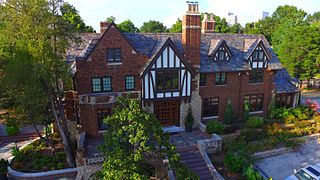
The McBirney Mansion in Tulsa, Oklahoma was the home of James H. McBirney, co-founder of the Bank of Commerce in Tulsa in 1904. He was the original owner of the mansion, built by architect John Long in 1928, and lived there until 1976. The mansion contained 15,900 square feet (1,480 m2) and sits on a 2.91 acres (11,800 m2) lot. The mansion was bought by Donna and Roger Hardesty who lived there for 5 years. Eventually it was bought by a law firm that turned it into a law office. By 2007, was purchased by former American Airlines President George Warde, who had plans to transform it into a boutique hotel. In the meantime, the McBirney Mansion was used as an event center. Warde died in 2012, and events stopped being held at McBirney. By February 2012, the Pauls Corporation, a Denver real estate management company, acquired the mansion as part of the suit's settlement. Tulsa attorney Gentner Drummond bought the mansion from Pauls Corp. in 2014, announcing his intention to make it his family's home.

Former U.S. president, businessman, and television personality Donald Trump currently has seven residences.
Edith Eleanor Schryver (1901–1984) was a founding partner of Lord & Schryver, the first female owned and operated landscape architecture firm in the Pacific Northwest from 1929 to 1969.
